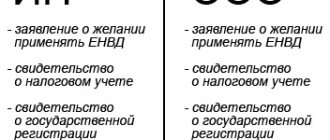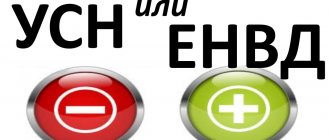Are you switching from UTII? Connect Kontur.Accounting
45% discount in November: RUR 7,590 instead of 13,800 rub. per year of work
Easy bookkeeping
The system itself will calculate taxes and remind you of the deadlines for payments and submission of reports.
Automatic calculation of salaries, vacation pay and sick leave
Technical support 24/7, tips inside the service, reference and legal database
Sending reports via the Internet
Reports and KUDiR are generated automatically based on accounting data
Electronic document management and quick verification of counterparties
Documents, transactions, analytical reports, VAT reconciliation
UTII and VAT in 2021
There are some features of paying VAT with UTII. According to current legislation, value added tax is required to be calculated by payers who apply the general taxation regime and are registered. If there is a transition to a preferential regime, which includes UTII, you do not need to pay this fee. But there are exceptions when VAT must be paid on UTII.
Such cases include operations for the import of goods from other states. When switching to special taxation regimes, the obligation to make payments is replaced by a comprehensive contribution.
In this case, the payer of contributions can perform the functions of a tax agent. In what situations can a combination of deductions and the application of a special regime occur:
- Transactions are carried out with foreign counterparties.
- Payments are made upon purchase or lease of municipal property.
- A vessel that has not been registered in the Russian registry is being sold.
It is possible to combine the regime and this contribution by organizations and entrepreneurs if they issue an invoice to the counterparty indicating the amount of the contribution. Then you will need to pay the tax and submit a tax return electronically.
Features of the main mode and “imputation”
OSNO is the basic taxation system that is assigned to taxpayers from the moment of registration. The main regime is considered complex due to the high tax burden: income tax, VAT, property taxes, personal income tax, and insurance payments are paid. To apply this system, the number of employees of the organization or individual entrepreneur, the structure of the company’s authorized capital and business lines are not important.
UTII is a special regime in which income tax, VAT, personal income tax (for individual entrepreneurs), and property tax are not paid. This regime is used for the areas of activity specified in the Tax Code of the Russian Federation and is applied by taxpayers whose staff number is no more than one hundred people, and no more than 25% of other organizations participate in the authorized capital. Unlike the main regime, imputed tax is calculated based on the values established by law, and does not depend on real profit.
It is impossible to combine OSNO and UTII in 2021. From January 1, imputation will be cancelled. Choose a new tax system using our online calculator: enter your parameters to find the most profitable regime. We answered the most popular questions about the abolition of UTII and the transition period in the article. If you don’t find the answer, ask your question in the comments, we will definitely answer.
Why is it necessary to combine OSNO and UTII?
The taxation algorithm assumes separate accounting of income and expenses, and other assets. Required insurance premiums are taken into account. If it is impossible to correctly distribute expenses, you will need to combine taxation under UTII and OSNO. A similar scheme will be needed for an enterprise combining wholesale and retail trade.
Another case when a combined scheme is suitable is cooperation with another enterprise that uses OSNO. This is the only beneficial type of tax regime for companies that do not use the simplified algorithm.
Combining UTII and OSNO: subtleties
The main thing when combining UTII and OSNO is to separate the accounting of transactions for them. To do this, you need to separately take into account the following indicators:
- income - according to the Tax Code of the Russian Federation, for “imputation” income is determined based on basic income, physical quantities and adjustment factors, and for the main mode, profit is calculated based on actual revenue and costs. At the same time, imputed income does not increase the income tax base, and the amount of revenue is not taken into account when calculating the imputed tax;
- expenses - the costs that a business incurs on the “imputation” cannot be taken into account when determining income tax and, vice versa. For example, if some employees are engaged in operations for imputed activities, and some - for those related to the main regime, then contributions from payments to employees in the “imputed” regime will reduce the imputed tax, and wages and deductions from it for “general regime” employees will reduce the income tax base ;
- VAT - “general regime workers” pay VAT, but “imputed workers” do not, therefore only input tax on transactions that relate to activities in the main regime is accepted for deduction;
- transport and property - for the purpose of calculating transport and property taxes, taxable objects must be taken into account separately by areas of activity related to different tax regimes.
Taxpayers who combine UTII and OSNO have costs that are common to business as a whole: office rent, accountant's salary. Such expenses are divided in proportion to income determined by the basic regime and the “imputed” regime.
UTII and OSN: the optimal combination
The combination of a general taxation regime and UTII in one organization is by no means uncommon. Naturally, the desire to save on tax deductions can result in difficulties for a company in organizing and carrying out accounting.
However, you should not despair, because it would still be possible to solve such a complex problem.
Joint mode – separate accounting
When an organization applies several tax regimes in its activities, for example, OSN and “imputed”, it must keep separate records for each of them (clause 7 of Article 346.26). Of course, in this case, the company’s accounting department must prepare the documents properly. Namely, the provision on separate accounting and the order on its organization in the company (or the order on separate accounting of property, business transactions and obligations). Moreover, these papers are supposed to reflect the following information:
– on the principle and form of dividing indicators by type of activity;
– about the documents on the basis of which separate accounting will subsequently be “built”, as well as the requirements for them;
– on the rules for the distribution of indicators simultaneously involved in several types of activities for each tax separately, in cases where the indicators cannot be unambiguously attributed to a particular activity.
In addition, the main points of maintaining separate accounting need to be fixed in the accounting policy of the organization, the development of which should be guided by the Law of November 21, 1996 No. 129-FZ “On Accounting”. Thus, when combining the general and “imputed” regimes, the accounting policy fixes:
1) the company’s chart of accounts listing subaccounts opened for separate accounting purposes. Moreover, such accounts must separately reflect indicators related to the special UTII regime and to those activities that are taxed in accordance with other taxation regimes; and in addition indicators to be distributed;
2) methodology for allocating indicators to sub-accounts opened for separate accounting purposes;
3) methods for assessing assets and liabilities based on separate accounting data;
4) necessary decisions to ensure compliance of separate accounting with the principles and rules of accounting and related to the peculiarities of the financial and economic activities of the organization.
Only in this case can you count on the possibility of maintaining full-fledged accounting and tax records. Unfortunately, the problems are not limited to the correct preparation of documentation and organization of separate accounting in the company, because many tax nuances must also be taken into account, which will be discussed below.
Taxation issues
The topic of tax accounting when combining different regimes deserves special attention. Let’s consider a situation where an organization carries out retail trade to individuals and “general regime” sales to legal entities that fall under UTII.
Income tax. In order to avoid distortions when calculating the base for this tax, you should distribute both your income and expenses between different types of activities. Interestingly, the opinion of the main financial department on this issue is very inconsistent. Thus, based on the letter of the Ministry of Finance dated March 14, 2006 No. 03-03-04/1/224, it was known that the distribution of expenses should be made on an accrual basis from the beginning of the year. In this case, the income, in proportion to which this breakdown of costs is carried out, must be calculated using the same method.
But recently the point of view of officials has changed. This time, the financiers decided that total expenses should be distributed monthly, based on revenue (income) and expenses for the month. For this purpose, the amounts of costs calculated at the end of the month based on the share of revenue received from types of “general operating” activities in its total amount received from all types are summed up on an accrual basis from the beginning of the year to the reporting date (letter of the Ministry of Finance of Russia dated December 14, 2006 No. 03-11-02/279).
Property tax. In the case of this tax, a dilemma may arise: how to correctly calculate its base if some of the company’s fixed assets are used both in “general regime” and in “imputed” activities? Traditionally, in such cases, the distribution method is used in proportion to income from activities taxed under the OSN in the total volume of revenue. It is noteworthy that financiers also propose to use this method. In their letter dated October 24, 2006 No. 03-06-01-04/194, officials, citing Article 346.30 of the Code, which states that the tax period for UTII is a quarter, indicated that the calculation should be made for every three months separately.
However, this method of distributing the residual value of property is not the only one. Thus, experts from the journal “Practical Accounting” remind you that to calculate property tax, you can distribute its value in other indicators, for example, based on the area of the property. To do this, the property tax base includes the value of the object in proportion to the area that is used in activities not subject to UTII (letter of the Ministry of Finance dated October 6, 2006 No. 03-11-04/3/436). However, it is possible to act in this way only in cases where the company’s inventory documents highlight the area on which activities subject to UTII are carried out.
Value added tax. The problem of separating accounting for this tax may arise if goods for “general regime” and “imputed” sales are purchased, so to speak, centrally. But it is still necessary to differentiate the taxation of further sales. Otherwise, the amount of VAT on purchased products cannot be deducted (clause 4 of Article 170 of the Tax Code).
As Ministry of Finance specialists indicated in their letter dated September 11, 2007 No. 03-07-11/394, in such cases the provisions of paragraph 4 of Article 170 of the Tax Code should be taken into account. This means that VAT amounts on “imputed” sales of goods must be taken into account in their cost. In turn, value added tax on transactions taxed under the general regime should be deducted in accordance with Article 172 of the Code.
Naturally, in the purchase book it will be necessary to record only amounts for “general regime” transactions. This is stated in paragraphs 7 and 8 of the Rules for maintaining logs of received and issued invoices, purchase books and sales books when calculating value added tax, approved by government decree No. 914 of December 2, 2000. If the goods will be used in transactions , subject to UTII, then the amount of VAT previously accepted for deduction is subject to restoration. Moreover, such “restoration” should be carried out in the tax period in which these goods were sold in the SES.
Numerical division
For organizations combining SSN and UTII, the question of calculating the number of personnel may also become relevant. After all, the same administrative and managerial apparatus is not directly related to any of the types of activities, but at the same time is indirectly involved in each of them. Financial department specialists believe that such employees should also be “separated” (letter from the Ministry of Finance dated November 28, 2006 No. 03-11-05/257).
To do this, the number of administrative and managerial personnel of the AUP, related to different types of activities, is calculated as the ratio of the “number” of managers to the total number of employees of the enterprise, multiplied by the number of employees employed in this type of activity. It is logical that if the result of calculations is a fractional number, then it must be rounded to the nearest whole number. At the same time, as the Ministry of Finance indicated in its letter dated July 17, 2007 No. 03-11-04/3/273, values of indicators less than one are discarded, and values that correspond to 0.5 or more are rounded to the whole unit.
Example
LLC "Service-M" combines UTII and the general taxation system. The number of administrative staff is 3 people; engaged in activities falling under the UTII regime – 7 people; in activities taxed under the regular taxation system - 5 people.
In this case, the calculation will look like this:
Average number of employees:
3 people + 7 people + 5 people = 15 people
Number of personnel excluding AUP:
7 people + 5 people = 12 people
Number of AUPs related to activities subject to UTII:
3 people : 12 people x 7 people = 2 people
The number of administrative and managerial personnel related to activities taxed under the general taxation system:
3 people : 12 people x 5 people = 1 person
Reporting when combining modes
Do you combine special modes? Easily keep separate records and pay salaries in Kontur.Accounting. The service will calculate taxes, prepare payment slips, remind you of payment dates and automatically generate reports for sending via the Internet. Get free access for 14 days
Simultaneous work on the “imputation” and on the main system implies that for each tax regime the corresponding taxes are paid separately and sets of reports are submitted. In this case, the principle of territorial registration applies: taxes on OSNO are paid to the legal address of the organization or according to the registration of the individual entrepreneur, and the imputed tax is transferred to the place of registration as a UTII payer for a certain type of activity. Reporting is presented according to a similar principle.
As for accruals from payments to employees, it does not matter what activities they are involved in: transfer of contributions and filing of reports occur for all employees at the legal address of the organization or at the registration of the individual entrepreneur.
Basic features of UTII
UTII is a special tax regime. The specificity is that taxes are paid not on real profits, but on planned income. Special coefficients approved for the year are taken into account. A similar scheme is used for accounting for types of activities listed in OKVED and OKUN. Each region has its own list of conditions and areas of business that fall under the terms of the UNM.
The combination of the OSNO and UTII tax regimes requires separate reporting and separate payment of deductions. The calculation is made according to a specific formula and is paid every quarter. For correct accounting, take into account:
- basic profitability (planned monthly income);
- physical indicators (varies for different fields of activity, includes the number of square meters of premises, number of employees, transport involved);
- federal adjustment factor;
- regional adjustment factor;
- tax interest rate.
Parameters are an unstable value; their indicators change throughout the year. Conducting separate calculations for both schemes, the amounts are distributed according to areas of activity. The list is approved by local legislative acts, for each region separately. Most often these are cafes, restaurants, shops and service centers.
Using such a scheme means exemption from the following types of taxes:
- at a profit;
- NFDL;
- for added value;
- on property;
- UST.
Instead, a single tax is transferred to the budget. Insurance premiums, deductions for water, transport, land rent and others are added to it. The list in each case depends on the field of activity of the enterprise or entrepreneur. The number of reports submitted is also reduced, which reduces additional labor costs.
How to add the main mode to the “imputation”
Since only the types of activities specified in the Tax Code of the Russian Federation are subject to imputed tax, operations that do not fall under the “imputed tax” will be in the main mode by default. As a rule, combining tax systems occurs in the following cases:
- expanding business by opening additional areas of activity that are not covered by the special regime - they will automatically be included in the main tax system;
- increasing the territory of operation of the company, when the corresponding type of activity was not registered as subject to imputed tax in the new location;
- termination of an activity previously subject to imputed tax - upon deregistration, all operations in this area of business are subject to income tax.
Please note that when opening new lines of business, the corresponding OKVED code must be indicated in the Unified State Register of Legal Entities. To enter the code into the register, you must submit an application to the Federal Tax Service to add types of activities.
The essence of the OSNO, USN, UTII modes
OSNO is a generally established taxation system to which almost the entire Tax Code of the Russian Federation is dedicated. Using this system, if there is an appropriate object of taxation, the taxpayer must pay all taxes in force on the territory of Russia.
At the request of the taxpayer, the Tax Code of the Russian Federation allows the use of special tax regimes, which can either replace OSNO or be used along with it. Such special regimes, in particular, include the simplified tax system and UTII, which are widespread in small and medium-sized businesses.
The simplified tax system can only be used instead of OSNO, and UTII can either replace OSNO or simplified tax system, or be used in conjunction with each of these modes.
Despite a number of similarities, the essence of the special regimes of the simplified tax system and UTII is fundamentally different. The simplified tax system is a simplified version of the OSNO, which, subject to the restrictions established by law, can be used by small organizations and individual entrepreneurs for any type of activity. UTII is applicable only to certain types of activities of companies and individual entrepreneurs, but it almost does not depend on the scale of this activity.
When both special regimes are applied, instead of the 3 taxes obligatory for payment on OSNO (profit, property and VAT), 1 tax (single) is paid. Although in some cases, along with this tax, there may also be a need to make payments for the taxes it replaces.
The algorithms for calculating this single tax under the simplified tax system and UTII are also completely different. Payment of other taxes and insurance contributions for the simplified taxation system and UTII systems, if there is an object of taxation, is just as mandatory as for the OSNO.
When applying all 3 taxation systems, firms are required to maintain accounting and prepare financial statements. SMP can do this using simplified options. Individual entrepreneurs are exempt from accounting and submission of accounting reports.
Both companies and individual entrepreneurs must keep tax records using OSNO and the simplified tax system.
With all options for combining modes, it is necessary to organize separate accounting and tax accounting.
Import of goods to the Russian Federation
The specifics of the procedure for calculating VAT when importing valuables into Russia are influenced by the country to which the supplier belongs.
If the “imputed” buyer buys valuables from a supplier from a country not included in the EAEU, then the purchased goods are placed under the customs procedure. In this case, the customs value is formed, to which the customs duty and, if necessary, accrued excise taxes are added. The result of the summation is used to calculate the added tax at one of the existing rates (18 or 10%). The resulting tax amount is subject to transfer while the goods are at customs.
The formula for calculation is:
VAT = (customs value + customs duty + excise taxes) * 10 (or 18)%
If a company imports goods on UTII from countries that are members of the EAEU, then the calculation and payment procedure is slightly different. The tax is calculated on the price amount specified in the contract. If the product is excisable, then the amount of accrued excise taxes is also added to the price.
VAT = (contract price + excise tax) * 10 (or 18)%
The tax calculated according to the specified formula must be paid before the 20th day inclusive of the month following the month of receipt of goods.
This procedure is provided for members of the EAEU, among which, in addition to the Russian Federation, are the following republics:
- Belarus;
- Kazakhstan;
- Armenia;
- Kyrgyz.
There is no need to charge VAT when importing goods listed in Article 150 of the Tax Code of the Russian Federation, which are exempt from the added tax burden.









